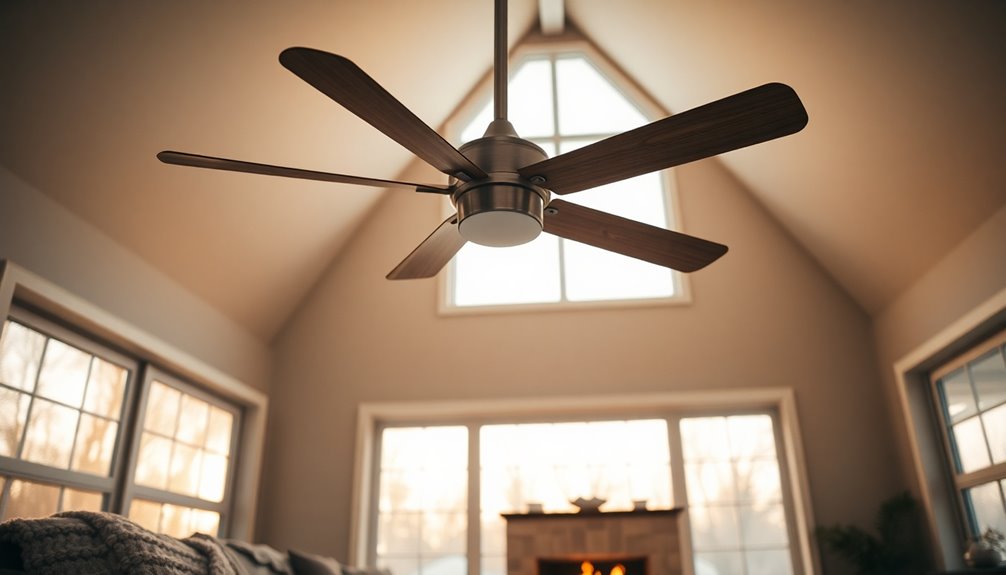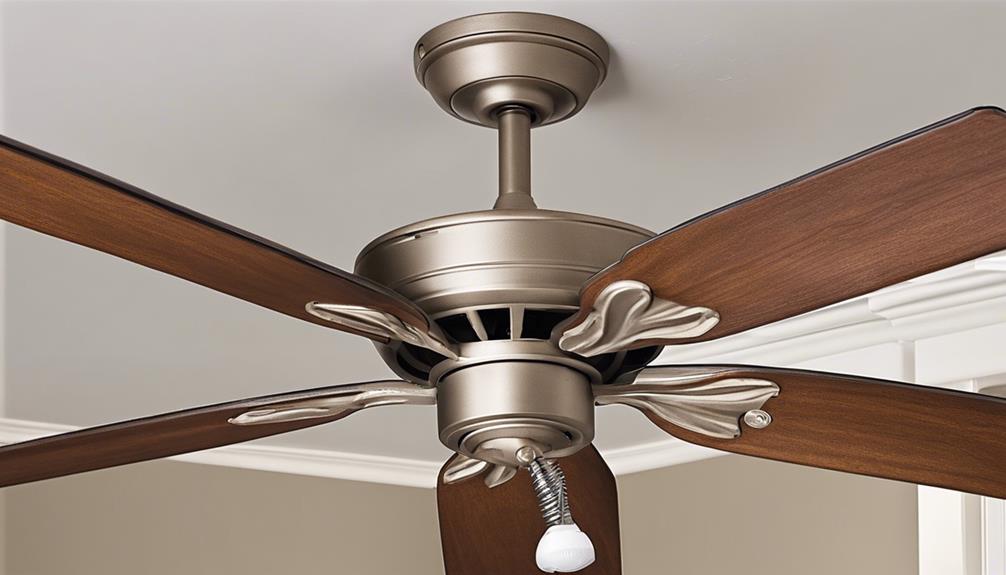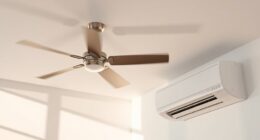To keep cool in the summer, set your ceiling fan to rotate counterclockwise. This direction creates a cooling downdraft, enhancing airflow and making you feel more comfortable. Running the fan at high speed can help you raise your thermostat by up to 4 degrees without feeling warmer, which can lead to significant energy savings. Remember to switch to clockwise in the fall to push warm air down for heating. Turning the fan off before changing its direction is essential for safety. There's more you can learn about optimizing your fan settings and boosting comfort throughout the season.
Key Takeaways
- Set the ceiling fan to rotate counterclockwise during summer for optimal cooling and airflow.
- High-speed operation enhances cooling, allowing you to raise the thermostat by up to 4 degrees comfortably.
- Ensure the blade angle is at least 12 degrees for effective cooling performance.
- Remember to turn off the fan before changing its direction for safety.
- Regular maintenance, including cleaning blades, improves airflow and prolongs fan lifespan.
Importance of Ceiling Fan Direction

When it comes to staying cool during the summer, getting your ceiling fan direction right can make all the difference. Setting your ceiling fan to rotate counterclockwise creates an invigorating downdraft that enhances cooling and airflow in your home. This simple adjustment can considerably improve your comfort levels while also reducing air conditioning costs.
By utilizing the ceiling fan switch to change the direction, you can maximize energy efficiency. A counterclockwise-spinning fan uses about 50 watts, vastly less than an air conditioning unit that can consume around 3,500 watts. This means you could potentially save up to 30% on your energy bills by relying more on your ceiling fan during the warmer months.
Additionally, maintaining a consistent room temperature helps reduce the need for excessive cooling, making your living space more comfortable. Regular use of a ceiling fan can also contribute to improved indoor air quality by reducing allergens and enhancing airflow throughout your home.
Summer Ceiling Fan Settings

To maximize comfort during the hot summer months, set your ceiling fan to rotate counterclockwise. This ceiling fan direction creates a cooling downdraft that effectively lowers the perceived temperature in your room. By generating a wind-chill effect, you'll feel cooler, allowing you to set your thermostat higher without sacrificing comfort. Running the fan at high speed can help you save on cooling costs, potentially reducing your energy bill by up to 30%. Additionally, modern Energy Star certified fans can enhance airflow, reducing reliance on air conditioning while contributing to lower energy bills.
Here's a quick reference table to guide your summer ceiling fan settings:
| Action | Result | Benefit |
|---|---|---|
| Set fan to counterclockwise | Creates a cooling downdraft | Feel cooler in the summer heat |
| Run at high speed | Increases airflow | Save on cooling costs |
| Adjust thermostat higher | Maintains comfort while saving energy | Reduces reliance on AC |
With proper configuration, your ceiling fan can enhance airflow, helping maintain consistent room temperatures. So, stand directly underneath the fan to confirm it's spinning counterclockwise and enjoy those breezy summer days!
Changing Fan Direction

Adjusting your ceiling fan direction is a simple yet effective way to enhance your summer comfort.
To change your ceiling fan for the summer months, start by ensuring the fan is turned off and has completely stopped.
Locate the reversing switch on the fan body if you have a pull chain model, or use the remote control for remote-operated fans to toggle the direction.
In summer, you want to turn your fan counterclockwise. This adjustment creates a cooling downdraft, which can make you feel a cool breeze throughout the room.
Standing directly under the fan can help you confirm that it's spinning counterclockwise and effectively circulating air. Additionally, using your ceiling fan in conjunction with your heat pump efficiency can further enhance your cooling experience and reduce energy consumption.
Timing for Direction Change

When it comes to changing your ceiling fan's direction, timing is key.
You should switch to counterclockwise as you spring forward for Daylight Savings in the spring, and reverse to clockwise when falling back in the fall.
This simple adjustment prepares your home for the changing seasons and keeps you comfortable all year round.
Daylight Savings Considerations
The shift into Daylight Saving Time offers a perfect opportunity to refresh your ceiling fan settings for seasonal comfort.
As you progress into spring, it's the ideal time to change the direction of your ceiling fan to counterclockwise. This setting is essential for the cooling season, as it helps circulate cooler air throughout your home, enhancing your comfort during warmer months.
When your ceiling fan blades rotate counterclockwise, they push air downward, creating a wind-chill effect that can make you feel cooler without lowering the thermostat. This not only keeps you comfortable but also helps save energy, as you can rely less on air conditioning.
Conversely, remember that when Daylight Savings Time ends in the fall, you'll want to change the direction of your fan back to clockwise.
This adjustment allows warm air to be pushed down, maximizing heating efficiency and maintaining a cozy atmosphere during colder months.
Seasonal Adjustment Timing
As spring arrives and you set your clocks forward, it's also time to think about your ceiling fan's direction. The ideal time to make this seasonal adjustment is during Daylight Savings Time, specifically as you spring forward.
By changing your fan direction to counterclockwise, you create a cooling downdraft that greatly enhances your comfort during the summer months.
To maximize energy efficiency, verify that your fan size is appropriate for the room. A well-sized fan operating in the correct summer direction can reduce your reliance on air conditioning, helping you maintain a comfortable room temperature while saving on energy costs.
Regularly adjusting the fan direction to counterclockwise at the start of summer is essential for improving performance.
Don't overlook the importance of this simple seasonal adjustment. By making this change, you not only improve your home's comfort but also contribute to a more energy-efficient environment.
Additional Energy Efficiency Tips

Maximizing energy efficiency in your home goes beyond just adjusting your ceiling fan's direction. Start by conducting a home energy audit to pinpoint areas where you can save energy. This will help you use your ceiling fans and other appliances more effectively.
Regular maintenance is also key; clean the blades and guarantee a tight installation to enhance your ceiling fan's performance. Additionally, maintaining your appliances with regular inspections can prevent costly repairs and improve efficiency. Understanding the importance of routine maintenance can significantly prolong the lifespan of your appliances.
A smart way to cool your home is to use ceiling fans alongside your air conditioning. This combination can lead to energy cost reductions of up to 30%. Be sure to adjust the fan speed and direction according to seasonal needs; during summer, set it to spin counterclockwise for a cool breeze.
If you haven't already, consider pairing your ceiling fans with ENERGY STAR-rated air conditioning systems. This can boost overall energy efficiency by about 8%, leading to further savings on your utility bills. Additionally, incorporating heat pumps into your home's energy system can further enhance your energy savings and sustainability efforts.
Staying informed about energy-efficient practices will guarantee you get the most out of your ceiling fans while keeping your home comfortable and your energy costs down.
Common Ceiling Fan Mistakes

You might be making some common ceiling fan mistakes without even realizing it.
One major error is forgetting to switch your fan to counterclockwise during the summer to maximize cooling.
Additionally, neglecting to adjust for seasonal changes can lead to inefficiencies that waste energy and limit comfort. Regular maintenance can prevent dangerous situations related to mechanical failure and ensure your fan operates efficiently.
Incorrect Direction Setting
Incorrectly setting the ceiling fan's direction can greatly impact your comfort during the hot summer months. If you forget to reverse a ceiling fan to turn counterclockwise, you might end up feeling warmer instead of cooler. This mistake not only affects your comfort but can also lead to higher energy costs as you might rely more on your air conditioning. It's vital to make certain the ceiling fan's direction creates a cool downdraft that guarantees cooling. Additionally, ensuring proper maintenance of your cooling systems, including ceiling fans, can enhance their efficiency and longevity.
Here's a quick reference to illustrate the differences:
| Incorrect Setting | Correct Setting |
|---|---|
| Turns clockwise | Turns counterclockwise |
| Creates an updraft | Creates a cooling breeze |
| Feels warmer in the room | Feels cooler in the room |
| Missed energy-saving chance | Up to 30% energy savings |
To make your home more comfortable, always check the fan and look for the reversing switch. You'll be glad you took the time to change its direction and feel that invigorating breeze directly above you!
Neglecting Seasonal Changes
Often, homeowners overlook the importance of adjusting their ceiling fan direction with the changing seasons, leading to inefficient cooling during summer. If you forget to make your ceiling fan turn counterclockwise, you're missing out on the cooling downdraft that helps circulate cool air throughout your space. This oversight can force you to rely more on your air conditioner, driving up your energy bills.
By simply flipping the switch on your fan, you can raise your thermostat setting by about 4 degrees without sacrificing comfort, which helps save money. Additionally, if you don't guarantee the blades are angled correctly—at least 12 degrees—you're likely diminishing the fan's cooling efficiency.
Regular maintenance is also key; clean the fan blades and check for proper operation to maximize performance. Neglecting these seasonal changes not only affects comfort but can also lead to unnecessary expenses.
Frequently Asked Questions
How Can You Tell if a Fan Is Going Clockwise or Counterclockwise?
To tell if a fan's going clockwise or counterclockwise, watch the blade movement. If it moves to the right, it's spinning clockwise.
Stand directly beneath the fan; if you feel a cooling breeze, it's counterclockwise. Conversely, if the air feels still or you sense a gentle updraft, it's clockwise.
Most fans have a reversing switch, so you can easily change the direction if you're unsure. Remote controls on modern fans often include this feature too.
Which Way for a Fan in Winter?
When the chill of winter sets in, it's time to cozy up your home.
You'll want your ceiling fan to rotate clockwise. This gentle, warm embrace helps push that warm air down, making your space feel inviting.
Running it on low prevents any pesky drafts while keeping your energy bills in check.
Which Way Should a Ceiling Fan Turn in Summer Reddit?
When you're looking for the best way to set your ceiling fan for summer, you want it to rotate counterclockwise. This direction creates a cooling downdraft that makes you feel cooler.
Stand underneath the fan and feel the breeze—it should be invigorating. You can usually adjust the direction with a switch or remote.
How Do You Tell the Direction of a Fan by the Blades?
You might think determining a fan's direction is complicated, but it's quite straightforward.
Stand directly under the fan and observe the blades. If they spin counterclockwise, you'll feel a cool breeze, indicating that's the correct setting for summer.
Also, check the blade angle; if they're tilted downwards, it's in cooling mode.
If you're unsure, use the reversible switch to toggle directions and confirm the airflow you feel.
Conclusion
In summer, setting your ceiling fan to rotate counterclockwise can make a big difference in comfort, creating a wind-chill effect that helps you feel cooler. Notably, using ceiling fans can lead to energy savings of up to 40% when combined with air conditioning. By keeping your fan's direction right and following energy-efficient practices, you can enjoy a more comfortable home while saving on your utility bills. So, don't overlook the power of proper fan direction this summer!









